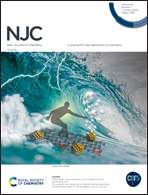Dissolution-enhanced emission of 1,3,6,8-tetrakis(p-benzoic acid)pyrene for selectively detecting protamine and “on-to-on” heparin detection in water†
Abstract
We developed a small organic molecule, 1,3,6,8-tetrakis(p-benzoic acid)pyrene (TBAPy), as a facile turn-on fluorescence probe for selectively detecting the basic protein protamine in water with a low detection limit of 24.14 ng mL−1. The TBAPy–protamine system could be further used as an “on-to-on” probe to detect the heparin protein with great fluorescence enhancement and simultaneous color change from green to blue. It can be explained by dissolution-enhanced emission (DEE) that the insoluble TBAPy probe is deprotonated to form the anionic species and dissolve in water, which suppresses the aggregation-caused quenching by electrostatic repulsion interactions. This DEE phenomenon is different from the widely reported aggregation-induced emission (AIE). These facile fluorescence “turn-on” and “on-to-on” methods for protein detection suggest that the DEE phenomenon is a very useful strategy for biosensing and can be potentially applied in food safety, disease diagnosis and healthcare.



 Please wait while we load your content...
Please wait while we load your content...